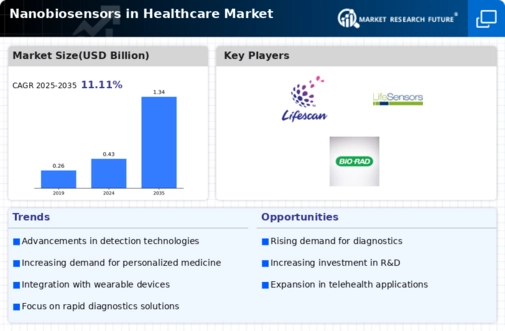Market Growth Projections
The Global Nanobiosensors in Healthcare Market Industry is projected to grow significantly, with estimates indicating a rise from 0.43 USD Billion in 2024 to 1.34 USD Billion by 2035. This growth trajectory suggests a robust compound annual growth rate of 10.92% from 2025 to 2035. The increasing integration of nanobiosensors in various healthcare applications, including diagnostics and monitoring, is likely to fuel this expansion. As technological advancements continue to emerge, the market is poised for substantial development, reflecting the growing importance of nanotechnology in healthcare.
Advancements in Nanotechnology
Advancements in nanotechnology are significantly influencing the Global Nanobiosensors in Healthcare Market Industry. The development of nanoscale materials enhances the sensitivity and specificity of biosensors, leading to improved detection of biomarkers. For example, gold nanoparticles are utilized in various biosensing applications, providing enhanced signal amplification. This technological evolution is expected to contribute to the market's growth, with projections indicating an increase to 1.34 USD Billion by 2035. The continuous research and development in nanotechnology suggest a promising future for nanobiosensors in diagnostics and therapeutic applications.
Government Initiatives and Funding
Government initiatives and funding play a crucial role in the growth of the Global Nanobiosensors in Healthcare Market Industry. Various countries are investing in research and development to promote the adoption of nanotechnology in healthcare. For example, funding programs aimed at supporting innovative healthcare technologies are becoming increasingly prevalent. These initiatives not only foster collaboration between academia and industry but also enhance the commercialization of nanobiosensors. As a result, the market is expected to witness a compound annual growth rate of 10.92% from 2025 to 2035, reflecting the positive impact of governmental support.
Increasing Prevalence of Chronic Diseases
The Global Nanobiosensors in Healthcare Market Industry is significantly impacted by the rising prevalence of chronic diseases such as diabetes, cancer, and cardiovascular disorders. These conditions necessitate continuous monitoring and early detection, which nanobiosensors can effectively provide. For instance, the use of nanobiosensors in cancer diagnostics allows for the identification of tumor markers at very low concentrations. As the global population ages and the burden of chronic diseases escalates, the demand for innovative diagnostic solutions is likely to grow, further driving the market's expansion.
Growing Awareness of Personalized Medicine
The Global Nanobiosensors in Healthcare Market Industry is benefiting from the growing awareness of personalized medicine, which emphasizes tailored healthcare solutions based on individual patient profiles. Nanobiosensors enable precise monitoring of biological markers, facilitating personalized treatment plans. For instance, the use of nanobiosensors in pharmacogenomics allows for the assessment of patient responses to specific medications. This trend towards personalized healthcare is likely to drive the demand for nanobiosensors, as healthcare providers seek to enhance treatment efficacy and patient outcomes.
Rising Demand for Point-of-Care Diagnostics
The Global Nanobiosensors in Healthcare Market Industry is experiencing a surge in demand for point-of-care diagnostics, driven by the need for rapid and accurate medical testing. These nanobiosensors facilitate immediate results, enabling timely clinical decisions. For instance, the integration of nanobiosensors in glucose monitoring devices has revolutionized diabetes management, allowing patients to monitor their blood sugar levels in real-time. With the market projected to reach 0.43 USD Billion in 2024, the emphasis on decentralized healthcare solutions is likely to propel further innovations in this sector.













